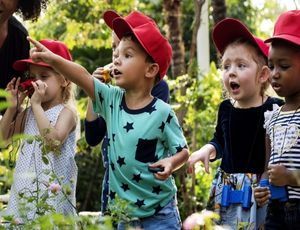Very early on, spoken language played an enormous role in the development of the child; when the baby is still in the womb, she hears the mother´s voice and reacts to it, then as an infant she looks intently at the moving lips of the speaker and tries to imitate them. As a young child, she forms bubbles and starts making sounds. It is clear that long before she can speak, she is capable of understanding a whole conversation. So, this month we will look into the importance of oral language as a connection with your child, the best way to encourage her to express herself, and the most common mistakes that might discourage her.
Every day we use hundreds of verbs, nouns, adjectives, and unique phrases to express ourselves and participate with other living beings. So, it makes sense that the development of language is intrinsically connected with the quality and amount of oral language a child is surrounded by. The richer the environment, the richer the experiences and the absorption of language, patterns, and tones the child will have.
Even if your child might not be speaking yet, she is already developing her spoken language; it takes many months to practice different lip and tongue movements, breathing patterns, and various tones of voice. Cooing, babbling, and even crying are many of the prelinguistic ways of communicating that allow young children to prepare their bodies to speak fluently later on.
Healthy skills to develop when communicating with children:
Avoid directive talk
Instead, foster two-way communication. This is very important, even if your child does not speak yet. We tend to use our words to explain what we are going to do, but it’s not often that we allow children to express their thoughts as well, especially if they are newborns or young infants. Observe your child, pay attention to her non-verbal communication, and try to act upon that. Another habit that is usually observed is the adult giving multiple commands to the child in short periods. For instance, “Pick up that,” “Put on your shoes,” “Be gentle,” etc. Directive expressions do not encourage any communication from the child; there is no opportunity for her to express. Remember, when we include them in open conversations, we are giving the child the vital message that her thoughts are valuable and that we trust she is capable of communicating with us.
Avoid baby talk
Naturally, most adults will adjust their tone of voice when talking with babies, but when we use our regular tone of voice with real words instead of diminutive words like “horsy,” it reminds us that we are talking to a whole person. If we think about it, how would we feel if someone came in and talked to us with diminutive words and in third person? We would probably feel disrespected and talked down to. The more children hear the proper language and tone, the sooner they will learn and try to speak it.
Avoid teaching words; use them instead.
The natural development of language happens when language is used naturally. There is no need to point to objects, name them, or ask the child to repeat it. Instead, use all-new vocabulary intentionally, in real situations and real, fluent expressions.
Be present; make eye-contact with your child.
When talking to children, we must be completely present in the situation, avoid multitasking, using technology, or having a conversation with others at the same time. Honor the attention your child is giving to your conversation with her.
Read books to your child
Most of the time, books are read at bedtime, but we don’t want to give the impression this is the only time to read. Books are a great tool to follow your child’s interests. Spend time looking at the pages and talking about what is happening. Vocabulary can be enriched so much when using books.
Take pauses and slow down
When talking to children, it is essential to slow down our rhythm. Children need time to absorb the sounds of the words and the movement of our oral muscles. Also, be patient and give pauses for your child to express. Sometimes it will take a few more seconds than you thought, but she must know that she will also have time to participate in the conversation.
Common mistakes that discourage oral language in children
Testing them
There is no need to ask children if they know the name of a particular item. By doing this, the child gets the message that we don’t trust how much she knows and that she needs to prove something to us. Remember, oral language first needs to be internally processed and then organically reproduced; this happens only when their body is ready, not when the adult demands an answer.
Using a pacifier
This item is mostly used for young infants. Many times, the adult hears the infant cry, and the immediate response is to put a pacifier in their mouth. However, the truth is that crying, babbling, and cooing are ways infants use to communicate. When we place a pacifier in their mouth, it is like putting them on “mute mode.” It gives them the message that we do not want to hear what they say, and there is no space for them to participate in a conversation with the adult. We must avoid giving the message that it is better to always be quiet than to express by any means.
Invalidating thoughts or feelings
The most used expression by adults is, “You are okay, don’t cry.” This is a tremendous mistake because most of the time, they are not okay; they are crying because something happened to them. They might feel down, bump their heads, or be sleepy. By telling them they are okay, we are entirely dismissing what they think and what to communicate, plus we are giving the wrong information about how it feels to be okay. Later on, they won’t like to be okay because that usually means crying. We must pay attention to what they tell us, acknowledge their feelings, and give an accurate, real answer to them. Plus, we don't want to teach them that crying is wrong.
Item of the Month
Books with Real Images
When developing language, children should be exposed to the real experiences, including books. There are many books with stories based on fantasy, but there are just a few with real images that a young child can identify quickly and absorb the right language naturally. Here are a few suggestions of books to read and explore with your child:
Link to buy some at Amazon.com:
https://www.amazon.com/-/es/gp/product/0590058991?colid=DXZP69VSXQ1T&coliid=I94HHVXZGCZI9&ref=br_ADD_TO_CART_title_link
https://www.amazon.com/gp/product/0763632929?colid=DXZP69VSXQ1T&coliid=ID9012MFO8OTL&ref=br_ADD_TO_CART_title_link
https://www.amazon.com/-/es/gp/product/1416989951?colid=DXZP69VSXQ1T&coliid=IWS3RN7Y2BPK4&ref=br_ADD_TO_CART_title_link
Video of the Month
The Promise to Georgia’s Children – Rollins Center for Language and Literacy
This 3:30 video reflects on two different scenarios of adults interacting with children. In the first scenario, there is a complete lack of language stimulation and connection. In the second scenario, the adult nourishes every conversation since they are young babies, and it mentions what a positive impact it has when they do it. Enjoy!
YouTube link: https://www.youtube.com/watch?v=QqljnK4HVaw
Quote of the Month
"Once the child can speak, he can express himself and no longer depends on others to guess his needs. He finds himself in touch with human society, for people can only communicate by means of language.…Very soon afterward, at one year of age, the child begins to walk….So man develops by stages, and the freedom he enjoys comes from these steps towards independence taken in turn…Truly it is nature which affords the child the opportunity to grow; it is nature which bestows independence upon him and guides him to success in achieving his freedom."
– Maria Montessori, The Absorbent Mind, p.78.



